You have all heard of “closed loop” fertility systems for growing food, right? This is what things like permaculture and biointensive growing methods aim to do.
In a closed-loop food production system, everything—including human waste—is recycled. Urine can be applied by peeing near mature plants. Or, it could be collected and diluted for use on annual vegetables.
You May Also Enjoy: “You Did WHAT To Those Farkleberries?! (Homesteading Basics)”
But what about human manure, a.k.a. poop?
Humanure
John Jeavons, advocate of the GROW BIOINTENSIVE® method and author of How to Grow More Vegetables, considers using human waste to be a critical part of sustainable fertilization. In his book, he tells gardeners to:
Explore proper, safe, and legal recycling of human waste. This subject remains taboo in many societies, however, research and establishment of best practices are critical for long-term sustainability. (Emphasis added.)
In other words, in a closed-loop system, human poop must also be collected, composted, and used to improve soil. Typically, this is done by combining human solids with sawdust to expedite composting. For food safety reasons, the humanure is allowed to age for at least 1 year prior to use.
For additional safety, aged humanure is often used under tall, perennial plants. This way, the harvested portions of the plants do not touch the humanure.
Personally, I am in favor of using my human waste for garden fertility. I am even planning to start doing it in earnest this year. (More on that in future posts!) And I am not the only one!
Farmers Use Human Waste, Too
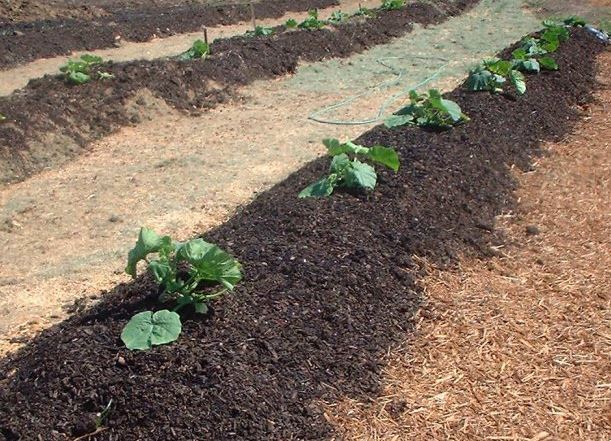
Image via Wikimedia
Many farmers already use human waste to grow food sold at grocery stores. Instead of composting their own humanure, though, they apply enormous loads of industrially processed municipal sewage waste solids to crop fields and pasture.
Isn’t That Great News?
Yeah . . . I know.
It sounded good in theory when it was your poop, your backyard, and your perennial plants. But, take that to an industrial scale and suddenly things get icky.
That’s because we know what gets flushed down toilets. And it ain’t just number 1 and 2!
It’s cleaning products, urine contaminated with pharmaceutical drugs, condoms, tampons, things too unspeakable to put down the kitchen sink (even though it all goes to the same place). It’s all those toxic beauty products that we healthy-living people avoid.
It’s also not just your waste. It’s everyone’s—waste from your neighbors, your coworkers, strangers, corporations, industries that produce and use toxic chemicals, hospitals, and more. It’s rain runoff, street pollution, and stuff that is never supposed to get into the sewage system but somehow does. (Supposedly an entire motorcycle once flowed into a Chicago sewage treatment facility!)
YES! Sewage Is Used to Grow Your Food
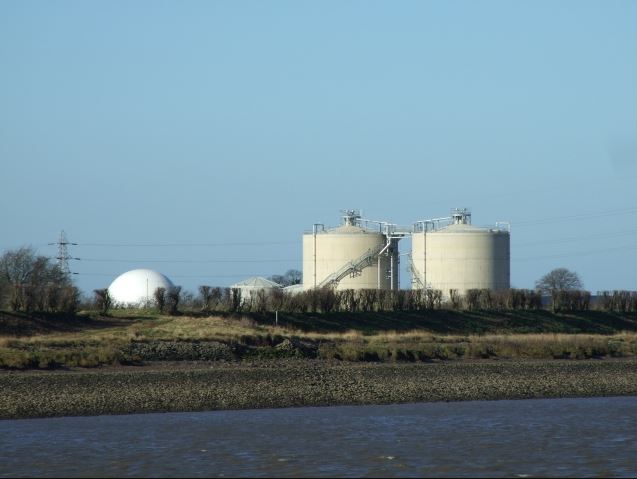
Image via Wikimedia
If this information is brand new to you, then I suspect you are wondering why no one talks about this.
Well, frankly, poo is taboo. It’s not exactly dinner-table, or grocery-store, conversation. Certainly, there are risks to farmers and waste-management processing facilities if we do start to talk about these things while eating our biosolid-grown breakfast cereal or pastured beef.
So, now, perhaps, you are hoping that I am just a conspiracy theorist. And I am making this up to sell you on the benefits of growing your own food and medicine at home. (Not a bad idea!)
Or, maybe you are hoping that the “powers that be” are ensuring this stuff is properly treated for biohazards before entering our food supply.
Behind the Biosolids
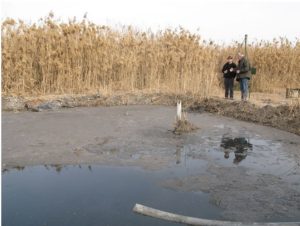
Image via Wikimedia
If any of the above thoughts occurred to you, I challenge you to do a quick Internet search for the word “biosolids.” (Biosolids is the term used to rebrand sewage sludge and make it more acceptable to the general public.) You will quickly discover the following:
- I am telling the truth—sewage grows some of your food. It’s used in all 50 US states and around the world. Your local agricultural extension offices often have the best information on how to use it.
- The EPA isn’t even sure these biosolids are entirely safe. They are in the process of conducting additional research to determine how dangerous it is and if further regulation is necessary.i (In the meantime, biosolids are still being applied to food crops.)
- The use of sewage to grow stuff happens because it must. If we don’t use it, where are we going to store 7.7 billion peoples’ poop, weighing in at 2,299,421,390 pounds each day?1)https://www.dailystar.co.uk/real-life/452131/Poo-chart-video-how-much-we-poo-in-day-world-Buzzfeed
In theory, using our processed waste is a great way to maintain fertility and return organic matter to the soil. Also, we have to if we want to close the loop and find more sustainable ways to grow food.
You May Also Enjoy: “6 Reasons You Should Call Your Extension Office Today”
In practice though, many biosolids are not adequately processed to meet the “safe” qualification also mentioned in How to Grow More Vegetables. In particular, these biosolids often contain a number of potentially toxic substances.
Let’s take a closer look at what these risks mean for food safety.
Are Biosolids Safe?
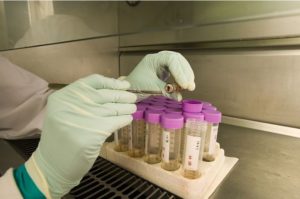
Image via Wikimedia
Technically, biosolids are not just raw sewage. They undergo mandatory treatments, regulated by the Environmental Protection Agency (EPA) in the US. That processing removes certain dangerous pollutants prior to application on farm fields, parks, and personal landscapes.ii
In fact, today, biosolids are even categorized as Class A and Class B to distinguish the levels of processing applied.
Class A: For Your Home
Class A biosolids can be packaged and sold to homeowners as fertilizer and garden soil amendments. They have been specifically treated to be less toxic to the average user. You may have purchased biosolids for home use already (e.g., Milorganite).
Class B: For Your Food Supply
Class B biosolids have been treated for some specific pathogens that cause lethal harm to humans. However, this class of materials is less processed than Class A biosolids.
Class B biosolids have a waiting period after application and prior to planting. This allows the biological life in soil time to metabolize unprocessed aspects of the sewage sludge. It also allows smells to dissipate.
Read More About Biological Life in the Soil Here: “The #1 Tool for Organic Growers”
These are typically only used by farmers and forestry management professionals, and their use may require a permit.
Survey Says: Safety Unknown
Both classes of biosolids are legal to use for growing food as long as the users follow the application guidelines. Unfortunately, there is increasing evidence that current biosolid processing procedures are insufficient to ensure food safety.
In response to the question, “Are biosolids safe?” the EPA answer is:
. . . additional scientific work is needed to reduce persistent uncertainty about the potential for adverse human health effects from exposure to biosolids.2)https://www.epa.gov/biosolids/frequent-questions-about-biosolids
The alarm over using toxic sewage sludge to grow food was raised in the late 1990s. It’s been hotly debated ever since.3)https://bioscienceresource.org/sewage-sludge-biosolids-land-application-health-risks-and-regulation-2/ New scientific knowledge about things like endocrine disruptors have made it more likely that use of biosolids may pose serious health risks.4)https://en.wikipedia.org/wiki/Endocrine_disruptor
The Potential Dangers of Biosolids
What was in the sewage, how each treatment plant processes it, and where it is applied determines the actual dangers of biosolids. In other words, not all biosolids are equally dangerous. However, here are some broad general concerns:
1. Heavy Metals
Arsenic and other heavy metals like cadmium, lead, and mercury have been found in many biosolids. These can be bioaccumulated by plants and passed on to humans in food. We already have justified fears about heavy metals like arsenic in apple juice,5)https://www.consumerreports.org/content/dam/cro/magazine-articles/2012/January/Consumer%20Reports%20Arsenic%20Test%20Results%20January%202012.pdf baby food,6)https://www.consumerreports.org/food-safety/heavy-metals-in-baby-food/ and rice.7)https://www.fda.gov/Food/FoodborneIllnessContaminants/Metals/ucm319870.htm
More metals going into our soils will certainly raise our risk factors. However, the extent to which heavy metals are taken up by plants and transmitted to end users (i.e., you!) varies greatly. Environmental conditions, the plants grown, and biological life in the soil can all influence bioaccumulation levels in our food supply.
2. Organic Pollutants
According to a report released by researchers at Cornell University:
It should also be of great concern for land application that the measured concentrations of persistent organic pollutants (POPs), including the brominated fire retardants (PBDEs) and the antimicrobial chemicals (triclosan and triclocarban), are so high in some sludges. These POPs are likely to build up in soils with repeated application, and have the potential to bioconcentrate in foraging animals and therefore in meat and milk.8)http://cwmi.css.cornell.edu/case.pdf
Given the array of consumer products, and the frequency with which new products are introduced, the risk for unintended interactions with these POPS are broad. Also, the complexity of trying to mandate the removal of dangerous products is staggering.
As such, even when dangers are known to exist, such as with triclosan9)https://www.fda.gov/ForConsumers/ConsumerUpdates/ucm205999.htm, updating legal regulations for processing biosolids can take years.
3. Pharmaceuticals
We already know that toxic, heavily regulated pharmaceuticals have a way of ending up in our meat supply. These are know to come from secondary sources such as irrigation water or accidents. Biosolids may be contributing to those food safety violations, as well.
You May Also Enjoy: “Are Banned Drugs Making Meat Unsafe to Eat?”
Antibiotics, chemotherapy by-products, and more may also be making their way into our food supply through these highly concentrated biosolids. Pharmaceutical drugs are very effective in small doses. That means even trace amounts can have big impacts on plants, animals, and humans.
You May Also Enjoy: “The 12 Most Dangerous Antibiotic-Resistant Superbugs”
4. Lots More Risks
These “big 3” are only the entry point for potential toxic substances in biosolids. If you want to take a deeper look at the dark side of sewage sludge, check out these resources:
“Crapshoot: The Gamble With our Wastes”
What Can You Do About It?
Biosolids are being used in farming. They are applied to about 1% of US agricultural land. But that figure could increase substantially in the future. And honestly, we have to do something with all our crap. It’s a shared planet, with finite resources, after all.
If I could wave a magic wand and make things right, I’d wish this:
- We’d all (individuals, corporations, hospitals, etc.) put fewer toxic things into our sewage system in the first place.
- Our processing centers would automatically remove all potentially toxic substances from the waste stream. (It’s not just biosolids we need to worry about. Our drinking water carries contaminants from our medical and chemical waste now.)
- We’d close the loop on fertility by using our waste products to nourish our soil locally. (Shouldn’t we all deal with our own crap, not send it downstream or around the world to others?)
You May Also Enjoy: “Antibiotics In Our Water Supply: The Hidden Threat”
Protect Yourself
Unfortunately, I don’t have a magic wand. Until we can make sure biosolids are safe for growing food, individual action is our best protection. Here are some things you can do to minimize your risks:
1. Grow Your Own Groceries
Make your own humanure with materials you can trust. Then, grow your own food to have greater control over food safety and quality.
2. Buy Organic
It’s illegal to grow certified organic foods using biosolids. Buying products that are certified organic isn’t a guarantee of safety. But, it does offer some assurances relating to biosolids risks.
3. Know Your Farmer
If you buy directly from farmers you trust, you can ask them about their farming practices. Better yet, if the farm is open to the public, you can go and see how the food is grown for yourself.
4. Support Labeling Laws
Ask your congress person to support the Sewage Sludge in Food Production Consumer Notification Act. Labeling foods grown in biosolids allows you to make informed purchases.
Follow this link to act now.
Conclusion
Using sewage to grow foods is a complicated issue. Sustainability requires responsible use of all waste products. Yet, public sewage content makes biosolids more risky than composting your own humanure at home.
I certainly don’t have all the answers. But being aware of the issues gives us more control over our personal health. Also, consumer opinions do matter. So, point your wallet where your worries are!
_____________________
The Grow Network is a participant in the Amazon Services LLC Associates Program, an affiliate program designed to provide a means for our team to earn fees for recommending our favorite products! We may earn a small commission, at no additional cost to you, should you purchase an item after clicking one of our links. Thanks for supporting TGN!

Tasha Greer is a regular contributor to The Grow Network and has cowritten several e-books with Marjory Wildcraft. The author of “Grow Your Own Spices” (December 2020), she also blogs for MorningChores.com and Mother Earth News. For more tips on homesteading and herb and spice gardening, follow Tasha at Simplestead.com.
References
| ↑1 | https://www.dailystar.co.uk/real-life/452131/Poo-chart-video-how-much-we-poo-in-day-world-Buzzfeed |
|---|---|
| ↑2 | https://www.epa.gov/biosolids/frequent-questions-about-biosolids |
| ↑3 | https://bioscienceresource.org/sewage-sludge-biosolids-land-application-health-risks-and-regulation-2/ |
| ↑4 | https://en.wikipedia.org/wiki/Endocrine_disruptor |
| ↑5 | https://www.consumerreports.org/content/dam/cro/magazine-articles/2012/January/Consumer%20Reports%20Arsenic%20Test%20Results%20January%202012.pdf |
| ↑6 | https://www.consumerreports.org/food-safety/heavy-metals-in-baby-food/ |
| ↑7 | https://www.fda.gov/Food/FoodborneIllnessContaminants/Metals/ucm319870.htm |
| ↑8 | http://cwmi.css.cornell.edu/case.pdf |
| ↑9 | https://www.fda.gov/ForConsumers/ConsumerUpdates/ucm205999.htm |
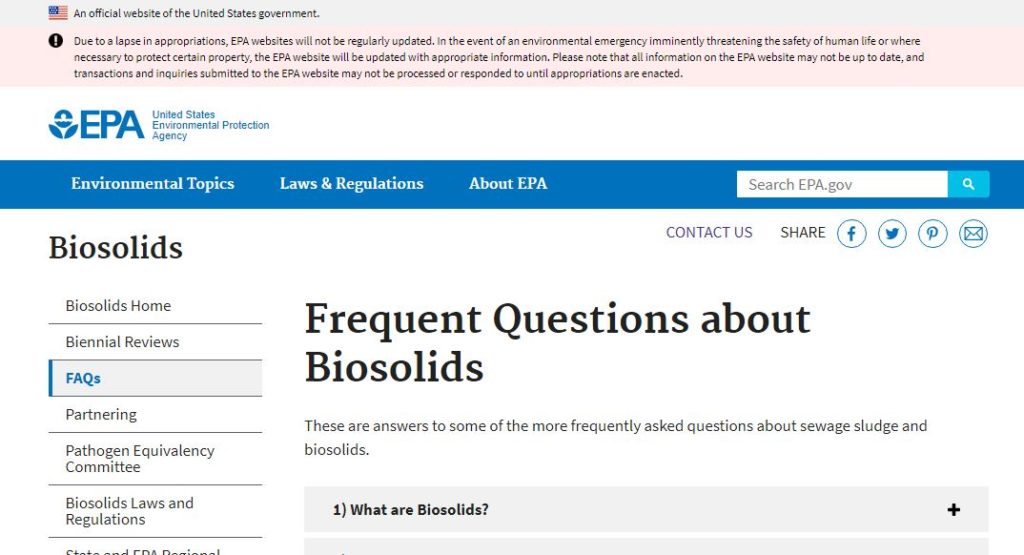







COMMENTS(8)
Great info. I’d be all for installing a humanure system here. But I doubt I could get the family onboard.
I have read a lot lately about PFAS showing up in products from farms using biosolids.
No matter where it comes from they can’t remove the chemicals and medications that people poop out!
I will not partake of any foods grown in human feces!
Look at the fish etc. taken from the waters around large cities where waste water is dumped AFTER treatment.
You are SO right Dezri. I’ll never eat food grown in that …. BUT how can you REALLY know unless it’s organic certified. Oh wait….. that might be changing soon. We try to grow as much as possible but there are foods we can’t and have to buy. We were buying “organic” eggs and than I found the grower giving them food clippings from non organic food! It’s so hard to trust people. This was one of my favorite market farmers too!
Hey Scott – I get the family not on board thing. I set myself up an outhouse with a view outside our house. So far, I am the only one in my house using it. It’s a mental hurdle to overcome in this age of conveniently flushing toilets. Maybe you could lead the way at home?
MattLenzi – You are right on that front. I read this recent article about PFAS in Michigan necessitating a big clean up in farms. https://www.apnews.com/32c65a5b3c27468ea2cdd2ce97848825 Thanks for reading and thinking about these issues.
Dezri – You are right. I am OK using my own compost manure because I am about as chemical free as it gets these days. But I certainly have huge reservations about how biosolids and even water treatment is being handled at the municipal or city level. Thanks for reading and caring about these issues!
Tasha can u tell me what ur processes after u have the poop in ur out house??? Thanks .. Mr.Wilson….